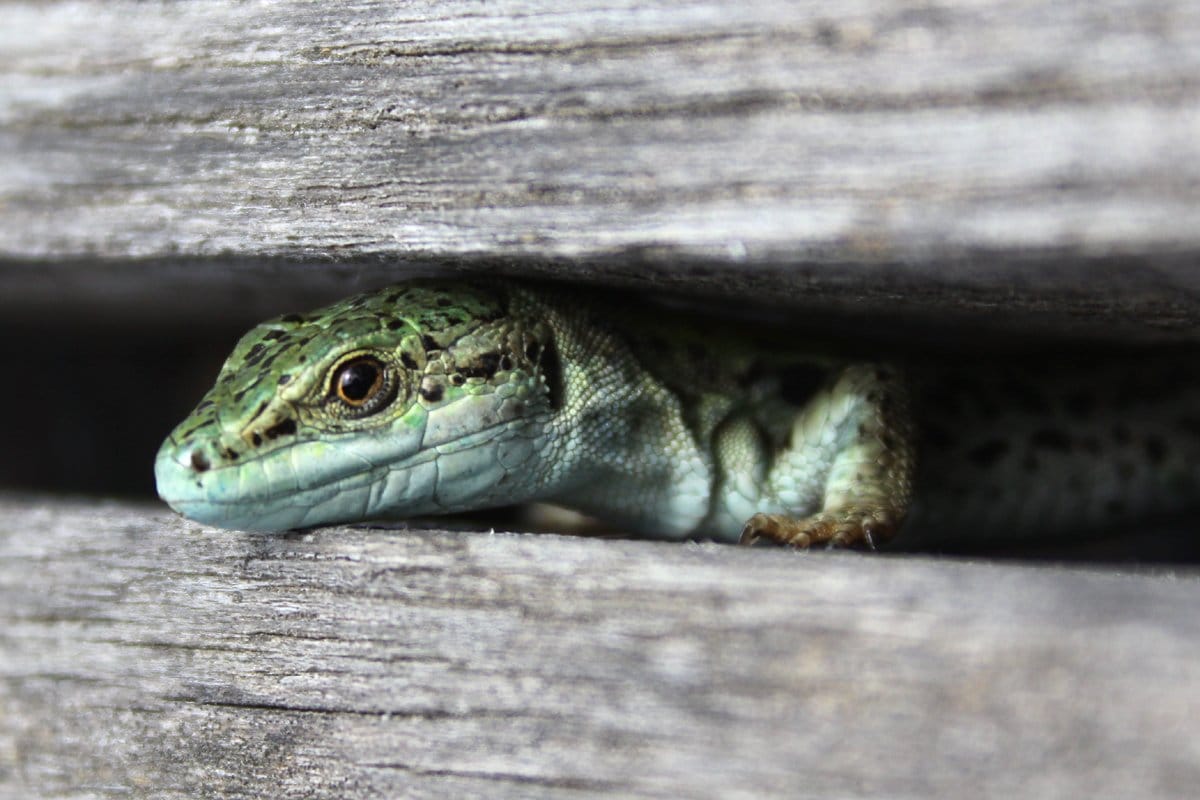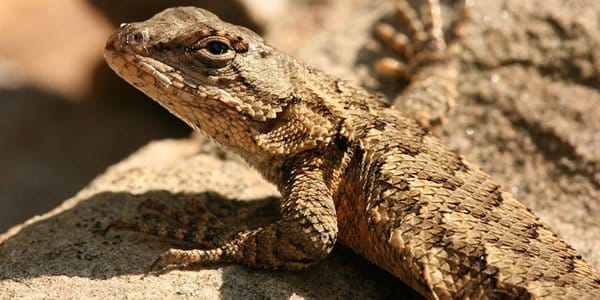New York City is well known as a city of immigrants so it makes sense that the only lizards living within the five boroughs are immigrants as well. Our northern winters and highly developed landscape make New York City inhospitable to most species of lizard and it is no surprise that the two species that do occur in the Big Apple have their strongholds in the outer boroughs.* The best bet for finding either species is to get into the proper habitat on a sunny day and to watch for them sunning themselves on rocks or gravel. It may seem odd to go searching for lizards in New York City but the idea of seeing the lizards in the major metropolitan area that is Gotham is too good to pass up for long. So what are the lizards that inhabit the interstices of the five boroughs and how did they get there?
Italian Wall Lizard at the Queens Botanical Garden (click for a bigger version)
The Italian Wall Lizard, also known as the Ruin Lizard was introduced to Nassau County, New York City’s eastern neighbor, in 1967, most likely from an accidental pet escape, and made its way west into Queens relatively rapidly. Podarcis sicula, as it is known in scientific circles, has continued to expand its territory, being found as far west as Manhattan and as far north as the Bronx. Originally found in Europe, the Italian Wall Lizard was shown in a research study to be a species that evolved rapidly when it was genetically isolated, and it would be interesting to see if the American population has developed any morphological differences.
The Eastern Fence Lizard, also known as the Northern Fence Lizard, the Prairie Lizard, the Pine Swift, and the Fence Swift, reaches the northeastern extremity of its range in southeastern New York State, in the four counties immediately north of the Bronx. The range of the species extends as far south as Florida and as far west as Mexico and Texas. Despite the fact that there is no record of a native New York City population and there certainly is no extant native population** Sceloporus undulatus can be found in Gotham. To be exact, there is a population in Staten Island, thanks to an intentional release of 29 individuals in 1942 by the herpetologist Carl F. Kauffeld, who had the hope of creating a local source of food for the lizard-eating snakes at the Staten Island Zoo.
Eastern Fence Lizard by Daniel Schwen (Creative Commons)
Sadly, the one lizard that was most assuredly native to New York City, the Five-lined Skink Eumeces fasciatus, was extirpated from the five boroughs. According to John Kieran’s Natural History of New York City they could be found foraging “around stones and logs in search of insects on which to dine.” Now one has to travel to Rockland County or Orange County, north and west of New York City or across the river into New Jersey to find a Five-lined Skink.
Though our two remaining lizards are both introduced species they are fun to look for and when one is lucky enough to actually spot one of New York City’s lizards it feels like an accomplishment. So get out there and see what you can see – it’s well worth it! Happy lizarding!
*Manhattan does have at least some Italian Wall Lizards, one of which can be seen in this blog post about to be eaten by an American Kestrel.
**I find it hard to believe that it would occur just north of the Bronx but never actually in the Bronx. Of course, the point is pretty much moot now considering the level of development that the Bronx has experienced.
…
Sources used in writing this post:
Lizards of New York State (link is a PDF)
Natural History of New York City by John Kieran
Amphibians and Reptiles of Long Island, Staten Island, and Manhattan
Wikipedia: Italian Wall Lizard and Eastern Fence Lizard
…















Huh? Lizards aren’t descended from dinosaurs; birds are. They’re still cool, tho.
@X: Oops. You are absolutely correct. Fixed. It must be the whole “Thunder Lizard” thing that got me confused…
Awesome blog. I have yet to go see the wall lizards.
The expansion of the Italian Wall Lizard locally is probably due to repeated introductions to new areas.
@Mike: Thanks! And go for it – they are well worth a visit!
@Seth: I thought the same thing but I can’t find any evidence of multiple releases. Of course, it is likely illegal to release non-native lizards, so it is not as if folks are going to advertise it…
And I thought the Lizards were found within the UN building trying to establish a New World Order. I always thought they were alien life forms taking over Earth, but you say Italian? Oh well, may as well be Italians then…
@Jochen: One must always keep an eye out for the lizard people. One of them was almost elected to the US Senate from Minnesota in 2008!
Cool lizards. I would have never guessed..
@Renato: I never would have either if it weren’t for a chance encounter with an Italian Wall Lizard!
Hey guys go to U tube, there are videos on Wall lizards in NYC (Brooklyn)
hi sir i wana asked that how can we distinguish between
a male and female wall lizard
@arman: No idea. Anyone out there know how?
you have really done your work very nice it is a good job i like your work.do you have an idea upon ASIAN lizards
i saw a lizard in front of my house last summer and this summer, but it wasnt either of these lizards, it looked more like an anole!
Just encountered a lizard at NY Bontanical Garden in Bx, thanks to this website I ID’d it as Italian wall lizard. I encountered it, appropriately, on top of a stone wall. So thanks for the lovely pic!
@Marian: Glad we could be of assistance.
hey, just checking. I have been working on 226 street in Laurelton and there are these little lizards – some a little bigger than chameleons. are these those italian wall lizards?
Yes, yes they are.
Queens Botanical Garden and NYBG are the two places I’ve seen the Italian wall lizard in the city, too. It wouldn’t surprise me if someone reported it from Bryant Park while looking under shrubs for Common Yellowthroats and Ovenbirds. In the QBG, they can usually be found in the gravel patch of Lavenders near the main building by the pond, or on the nearby flagstones. That gravel patch grows California poppies like anything — big, healthy plants like the ones that only occur in my garden right before frost, but only in the standard golden orange. Which does make a nice contrast with the Lavender, but come on, how about a few rose pink, champagne buff, ivory, and purple-pink types? The kind I’m trying to grow in my part-shade yard?
I live in Manhattan and Live 38 floors up but my veranda has shrubs and small trees that act as barriers between verandas. I keep seeing a lizard on the bricks sunning! Is this normal.? Am I the only human ever to experience this?? Yes this time of year 4/25! Please reply
I don’t know if it is normal but I am not terribly surprised. Reptiles are great climbers!
Thanks for the posting, saw two Lizards in Queens Botanical Garden yesterday and realized I had never seen one in NYC before. Now I know what they are and how unusual lizards are for the City.
Awsome article. I’m a huge lizard fanatic & have been tracking these guys and their populations. Found them in 4 of the 5 boroughs, were in Manhattan are they?
My son just told me that he saw ONE lizard in Friend’s field in Brooklyn. That’s a park. He saw it right near the baseball field dugout. He said he saw hit a few times going in and out of a pole.
I have found an Italian wall lizard as far out on Long Island as east patchouge. I would be happy to share a picture with anyone that would like to see it . It was quite fat and healthy looking. My email is rendrag17@yahoo.com
Just saw two of them at a park on 18th ave and 58th st in Brooklyn. I was so surprised.